Comparison of Non-Maximal Tests for Estimating Exercise Capacity
Abstract
Although maximal incremental exercise tests (GXT) are the gold standard for outcome assessment and exercise proscription, they are not widely available in either fitness or clinical exercise programs. This study compared the prediction of VO2max in healthy, sedentary volunteers using a non-exercise prediction (Matthews, Heil, Freedson & Pastides, 1999), RPE extrapolation to 19 & 20 (Eston, Lambrick, Sheppard & Parfitt, 2008) and the Rockport Walking Test (RWT)(Kline et al, 1987) and of VT using the Talk Test (Foster et al., 2018) and RPE @ 13,14,15. Subjects performed treadmill GXT with gas exchange, submaximal treadmill with RPE and Talk Test, the RWT and the Matthews non-exercise estimation. All methods provided reasonable estimates of both VO2max and VT, with correlations >0.75 and SEE ~1 MET. VO2max was best estimated with extrapolation to RPE=19. VT was observed intermediate between the Last Positive & Equivocal stages of the TT and between RPE 13 & 14. Non-maximal evaluation, and even non-exercise equations can be used as a substitude for maximal GXT with gas exchange to make reasonable estimates of both VO2max and VT.
Downloads
Published
How to Cite
Issue
Section
License
Copyright (c) 2020 Kinesiology

This work is licensed under a Creative Commons Attribution-NonCommercial 4.0 International License.
At Faculty of Kinesiology we recognize that access to quality research is vital to the scientific community and beyond. Kinesiology is non-profit journal and all costs of publishing and peer review process are covered by the publisher itself or other funding sources like Ministry of Science and Education of the Republic of Croatia. Full text papers are also available free of charge at http://hrcak.srce.hr/kineziologija. There are no restrictions on self archiving of any form of paper (preprint, postprint and publisher's version).
Articles are distributed under the terms of the CC BY - NC 4.0
Kinesiology does not charge any fees to authors to submit or publish articles in our journal.


